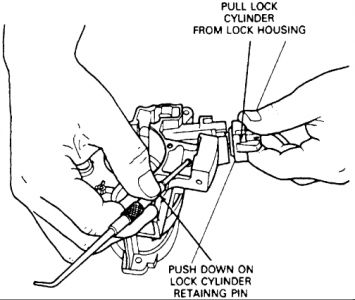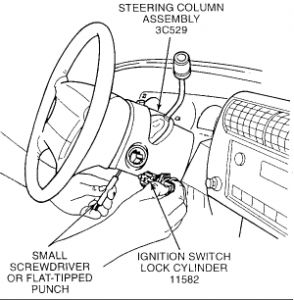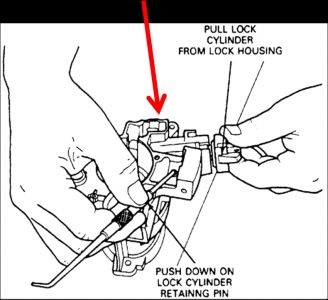Hello,
It sounds like to me you do not have it engaged and locked into position.
As you see by the steps in the attached you have to turn the key to run engage lock into position.a re you sure you rotated the cylinder and locked it into position?
Please make sure it is seated and do the functional check.
Note: The following procedure applies to vehicles that have functional lock cylinders, ignition keys available for the vehicle, or ignition key numbers that are known and the proper key can be made.
REMOVAL
Disconnect battery ground cable, then remove steering wheel.
Note: Ensure steering wheel is in full up position on models with tilt steering.
Turn lock cylinder key to run position.
On models with tilt steering, remove tilt lever, then the steering column collar by pressing on collar from top and bottom while removing.
On all models, remove lower dash panel trim cover, then the column shroud retaining screws from bottom of column shroud.
Remove bottom half of shroud by pulling shroud down and toward rear of vehicle. Move shift lever as required to ease shroud removal on models with automatic transmission.
Lift top half of shroud from column.

Push down on lock cylinder retaining pin using a 1/8 inch diameter wire pin or small punch, then pull lock cylinder from column housing, Fig. 2.
Disconnect lock cylinder electrical connector from horn brush electrical connector.
INSTALLATION
Lubricate lock cylinder with suitable grease, then turn lock cylinder to Run position and depress retaining pin.
Insert lock cylinder into housing in flange casting, ensure tab at end of cylinder aligns with slot in ignition drive gear.
Turn key to OFF position, allowing cylinder retaining pin to extend into cylinder casting housing hole.
Rotate lock cylinder to all positions, ensure cylinder is operating properly.
Connect lock cylinder electrical connector to horn brush electrical connector.
Position top half of steering column shroud onto column so that screw moldings on shroud seat in mounting bores in column. Place shift lever in lowest position to aid assembly on vehicles with automatic transmission.
Install bottom half of shroud by sliding guides in bottom half of shroud into tabs in top half.
Install shroud retaining screws and torque to 18.5-25.6 inch lbs.
On models with tilt steering, install steering column collar by pressing on top and bottom while installing on column.
Install tilt lever and torque to 2.2-3.6 ft. lbs .
On all models, install steering wheel.
Install lower dash panel trim cover, then connect battery ground cable.
Check for proper start in P and N, and ensure vehicle cannot be started in D or R positions and steering wheel locks in LOCK position.
Ignition Switch Lock Cylinder
NOTE: The following procedure applies to vehicles that have functional lock cylinders and keys. If key numbers are known, the proper key can be made.
Lock Cylinder Functional
Removal
Disconnect battery ground cable (14301).
Turn lock cylinder key to RUN position.
Remove lower shroud as outlined in this section under shroud removal.
Place a 3.17mm (1/8-inch) diameter wire pin or small drift punch in hole in steering column under lock cylinder. Depress retaining pin while pulling out on lock cylinder to remove it from housing of steering column.

Installation
Install lock cylinder by turning it to RUN position and depressing retaining pin. Insert lock cylinder into steering column housing. Make sure ignition switch lock cylinder is fully seated and aligned in interlocking washer before turning key to OFF position. This will permit retaining pin of ignition lock cylinder to extend into hole of steering column.
Rotate lock cylinder, using key, to make sure of correct mechanical operation in all positions.
NOTE : When the battery (10655) has been disconnected and reconnected, some abnormal drive symptoms may occur while the powertrain control module (PCM)(12A650) relearns its adaptive strategy. The vehicle may need to be driven 16 km (10 miles) or more for powertrain control module to relearn the strategy. Connect battery ground cable.
Monday, December 29th, 2008 AT 8:02 AM



